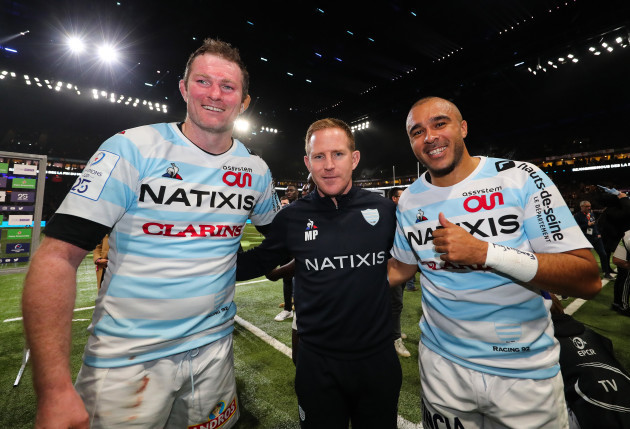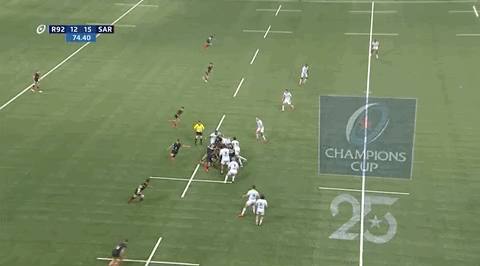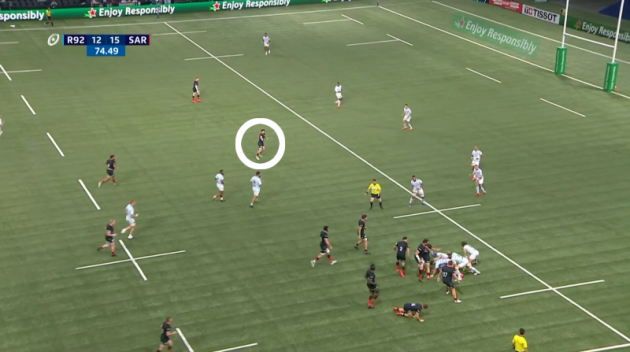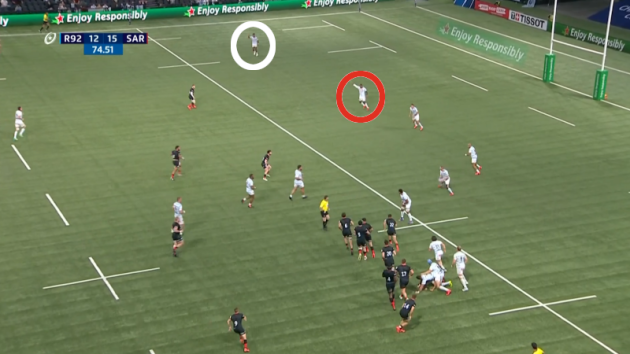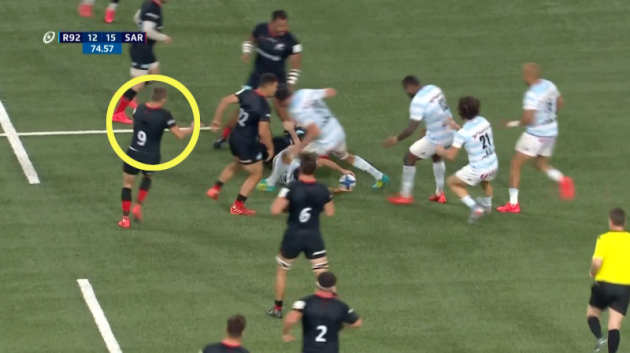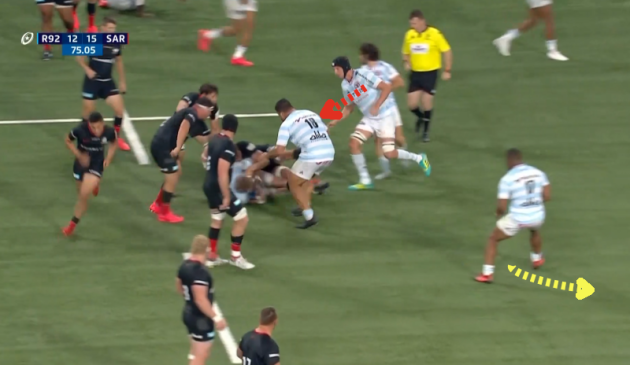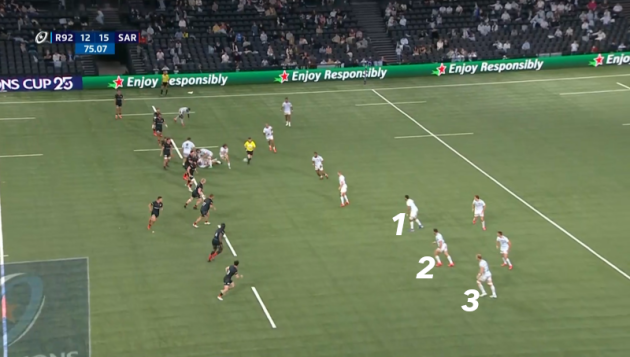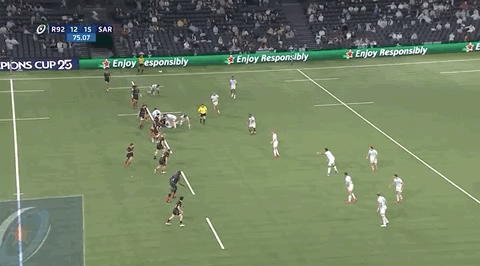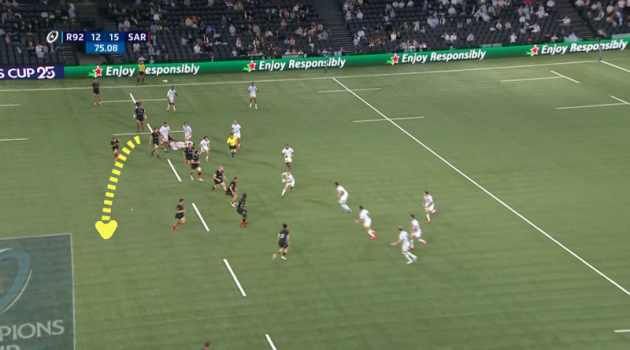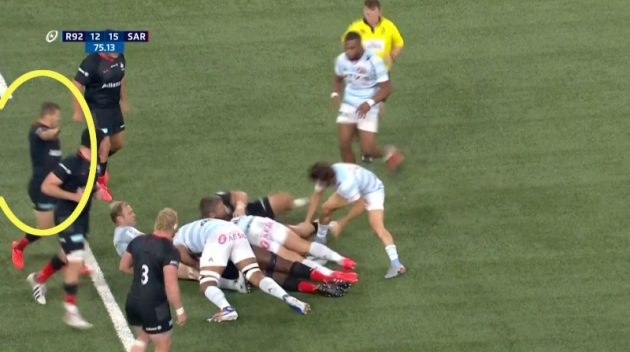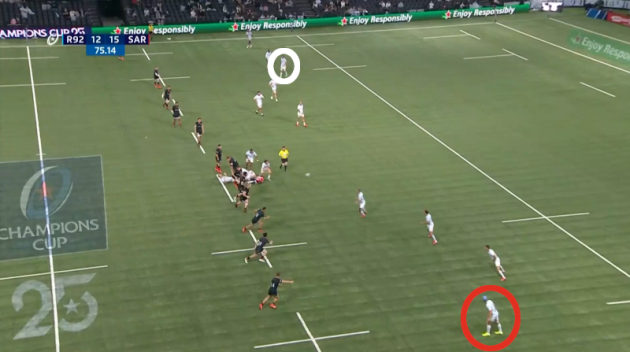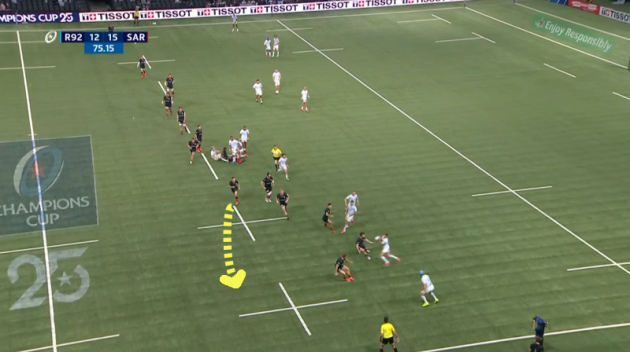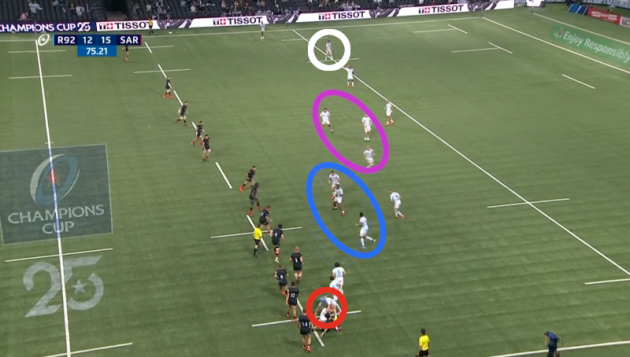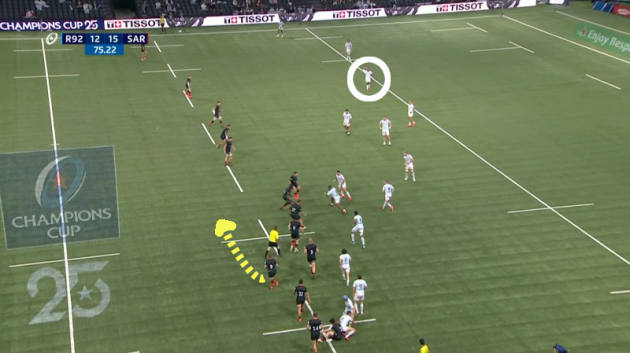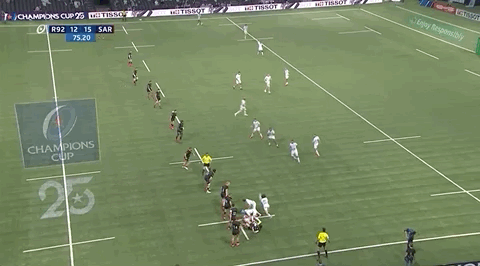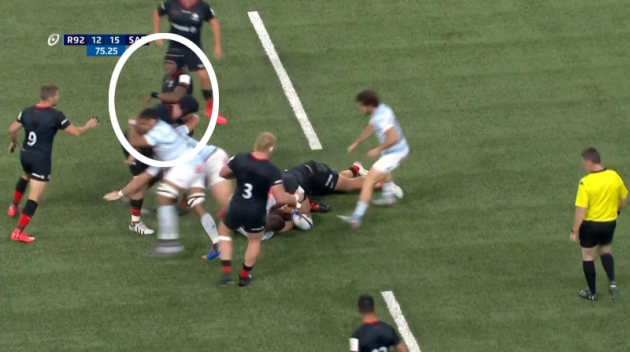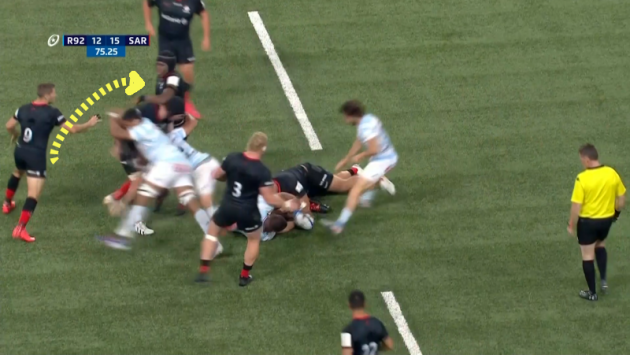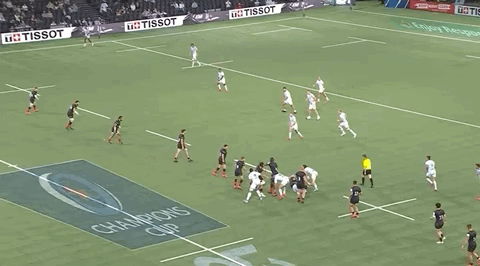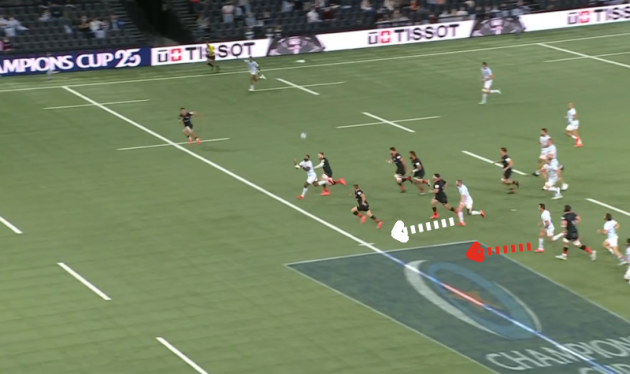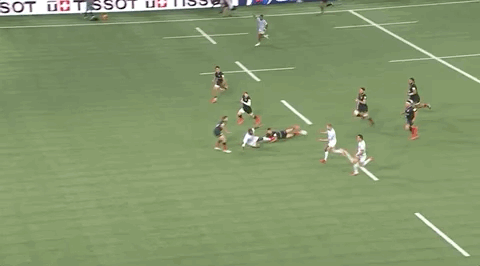IT WAS THOROUGHLY fitting that a flash of attacking quality from Racing 92 secured their place in the Champions Cup final after a turgid, arm-wrestle of a semi-final against Saracens last weekend.
Finn Russell, Virimi Vakatawa, Russell again, Juan Imhoff – this was a wondrous score to send the French outfit into their third European decider.
The late try underlined the excellent work that Irish attack coach Mike Prendergast has been doing with the Top 14 side since joining last year.
The former Young Munster director of rugby has earned an ever-growing reputation in France since first joining Bernard Jackman at Grenoble in 2013, moving onto stints with Oyonnax and Stade Français before linking up with Racing in 2019.
“You give boys a framework, there’s a system there and you want them to express themselves,” Limerick man Prendergast told us of his philosophy ahead of the Saracens game.
“You don’t take away from what they bring to the table.
“You see that with some of our backs like Virimi and obviously Finn. When you have a guy like Finn who can make those late decisions on the line and people read off him, you leave him at it.”
The winning try against Saracens started deep inside Racing’s half as they countered off a kick reception, with Imhoff the man to field Richard Wigglesworth’s kick.
We can see above that Racing have already started to work downfield before Wigglesworth has kicked the ball, looking to set themselves up for a counter-attack as early as possible. While many French sides are strong in this aspect of counter-attacking play, Prendergast has encouraged it even more.
It means the Racing backs are primed to counter immediately after the ball is recycled, whereas Saracens look uncharacteristically disorganised in the shot below.
The Saracens forwards are bunched around the ball as centre Dom Morris [white above] frantically signals for them to spread out into the defensive line.
Saracens had lost key defensive leader Brad Barritt to a head injury at this stage of the game, and his presence and communication skills were certainly missed in the closing 15 minutes.
Having held their width, Racing identify the opportunity on their right as Vakatawa [red below] and Teddy Thomas [white] call for the ball.
Russell passes to centre Olivier Klemenczak and with the Saracens defence jockeying across the pitch, the French midfielder opts to carry outside Morris, making around 20 metres of progress upfield.
Vakatawa arrives at the breakdown and makes an instant decision to pick and carry right…
… which keeps the Saracens defence moving and also allows Racing to use the full width of the pitch.
It’s crucial to note that Wigglesworth [yellow below] is up in the defensive line here.
Wigglesworth had spent much of this game defending in the backfield as part of Saracens’ 13+2 defensive system [13 defenders in the frontline, with two staying in the backfield to cover kicks] when Racing were in possession in the middle third of the pitch.
However, here in the 75th minute of the game, Saracens switch to a more aggressive 14+1 system, leaving only Alex Goode permanently stationed in the backfield. Perhaps they felt it was important to have another frontline defender presuming that Racing would hold possession as they chased the game, so McCall’s men took a punt in leaving the backfield more exposed.
As we’ll see, Wigglesworth does still work to cover kick space but Racing pick their moment to strike perfectly.
As Vakatawa carries on the right, Racing get into their attacking “framework.”
In this case, it looks like a basic 1-3-3-1 shape as scrum-half Maxime Machenaud passes left to a pod of three forwards in ball-carrier Dominic Bird [1 below], plus prop pair Ali Oz [2] and Hassane Kolingar [3].
We can see that Russell is hovering out the back of the pod as Bird carries.
There’s a good decision from Kolingar here, as he recognises that Baptiste Chouzenoux [red below] is coming from the right-hand 15-metre channel to provide a clearout from the inside, so the prop backs away [yellow] rather than unnecessarily committing to the breakdown.
On the next phase, Russell steps up as first receiver with the second pod of three forwards outside him in Boris Palu [1], Teddy Baubigny [2], and Antonie Claassen [3].
We can see that Kelemenczak and Imhoff are set up in behind the pod of forwards but Russell is keen to test the Saracens defence with a front-door pass to hooker Baubigny in this instance.
It’s really important to keep an eye on Wigglesworth in the Saracens defence above because Racing are certainly doing that themselves.
As Machenaud passes from the ruck, Wigglesworth [yellow below] drops out of the frontline defence and sweeps behind to cover the possible kick space…
… before rejoining the line at the fringe of the breakdown after Baubigny is tackled…
Racing play to their left again with Russell at first receiver and we can see how flanker Wenceslas Lauret [red below] has held the width out on the left edge throughout this passage of play.
Wide on Racing’s right, Chouzenoux [white above] doing the same thing as part of Prendergast’s attacking framework.
Again, Russell throws a lovely flat pass here and it very nearly sets Imhoff free, only for Morris to make a sharp tackle turning to his outside.
Watch Wigglesworth again in the clip above as he performs a similar role, dropping in behind the frontline…
… before ending up on the fringe of the breakdown.
Having exhausted the space on their left, Racing now bounce back infield and we can see how well they have preserved their width, something Prendergast is always keen for them to do.
The two pods of three forwards [blue and purple] are clear, with Kolingar set up in the middle of the first one, ready to carry after opting against committing to that earlier breakdown.
Just as Kolingar receives the ball from Machenaud, we can see that Vakatawa [white below] is signalling to Russell, who revealed after the game that his outside centre had called the chip kick that will follow.
As Kolingar carries into the Sarries defence, we can see that Wigglesworth [yellow above] has once again taken off on the same sweeping line behind, but the Kolingar carry itself is essential to the success of the kick that follows.
Kolingar has a well-set defence in front of him, but having made a good decision not to commit to that earlier breakdown and therefore preserved energy, he is explosive with his carry.
The loosehead bounces Maro Itoje off and drives forward through Richard Barrington’s tackle to just about win the gainline, when it would have been so easy to lose it.
The other two Racing forwards in this pod – Palu and Baubigny – then clear out Itoje and Tim Swinson, tying them into the ruck, as we see below.
Prendergast has put a major focus on Racing’s breakdown work since last year, ensuring that his players understand the value of getting lighting-quick ruck ball and also tying in defenders whenever possible.
Swinson and Itoje might feel they could have done more to fold around the corner into the defensive line here rather than getting caught up, but they’re exhausted after their second full game in two weekends.
Racing’s bench forwards made a major impact in this game, while Saracens’ lack of trusted bench forwards was exposed in a manner that Leinster, to their regret, never managed to achieve after leaving themselves so far behind in the quarter-final.
The knock-on effect of Itoje and Swinson being tied up in the breakdown is that Wigglesworth has to plug the hole on the fringe of the ruck.
Wigglesworth has several genuine threats to worry about here, so he’s not just hovering around the fringes and then dropping behind early as was the case before.
There’s the possibility of Machenaud scooting off the ruck [yellow below].
Racing left wing Imhoff [red above] is also working around the corner to pose another threat, something that Prendergast has thoroughly encouraged from his wide men – getting off their wings and involved in play. We saw this throughout the semi-final, while fullback Simon Zebo also has a license to pick clever lines off Russell.
Meanwhile, Claassen [white above] is even a potential inside pass option off Russell, who has split the three-man pod around him. All of these elements of Racing’s system provide the platform for the individual skill of the team to come to the fore…
Russell’s kick is sublime as he measures the weight of it perfectly, allowing Vakatawa to continue sprinting onto the ball and gather it on the full, rather than having to slow or attempt to retrieve a bouncing ball as fullback Goode closes up on him.
Meanwhile, Wigglesworth is reacting late having had to stay in the defensive longer on this occasion…
The ball actually bounces off Vakatawa’s head first but he’s able to gather it and get it into his right hand just before the desperate Wigglesworth engages into the tackle, meaning the Racing centre can fend him with his left hand and offload with his right just as Goode also commits up onto him.
Russell [white below] has done brilliantly post-kick to immediately chase upfield…
… as he looks for a second touch, while Imhoff [red above] has worked through in support too.
Had Imhoff simply stayed on his left wing, the play would likely have ended with Russell being tackled by the scrambling Elliot Daly, but instead he can move the ball on to the lighting-quick Imhoff for the finish.
This is wonderful stuff from Russell and co. but it doesn’t just happen by accident.
“It’s something that we practise a lot in training,” said the Scotland out-half of the chip kick post-game and we have seen it very recently from Racing.
Below is Russell’s assist for Vakatawa’s try against Montpellier just two weeks before in the Top 14, with the out-half working hard upfield after his kick, as hooker Camille Chat also chases impressively.
This kind of attacking kick is something that Prendergast has driven hugely since his arrival in Racing.
We have seen many other examples of Russell and Racing chipping, kick-passing and grubber-kicking under 43-year-old Prendergast’s coaching, with the Irishman keen to get the most from this remarkably talented group of players.
The easy thing for someone in Prendergast’s shoes would be to over-coach a squad like this, enslaving them to rigid structures and inadvertently stifling their inherent qualities.
Instead, Prendergast has been giving his players a simple framework, pushing their technical skills, encouraging good habits and a strong work ethic, and allowing them to showcase the talent that made them Racing players in the first place.
